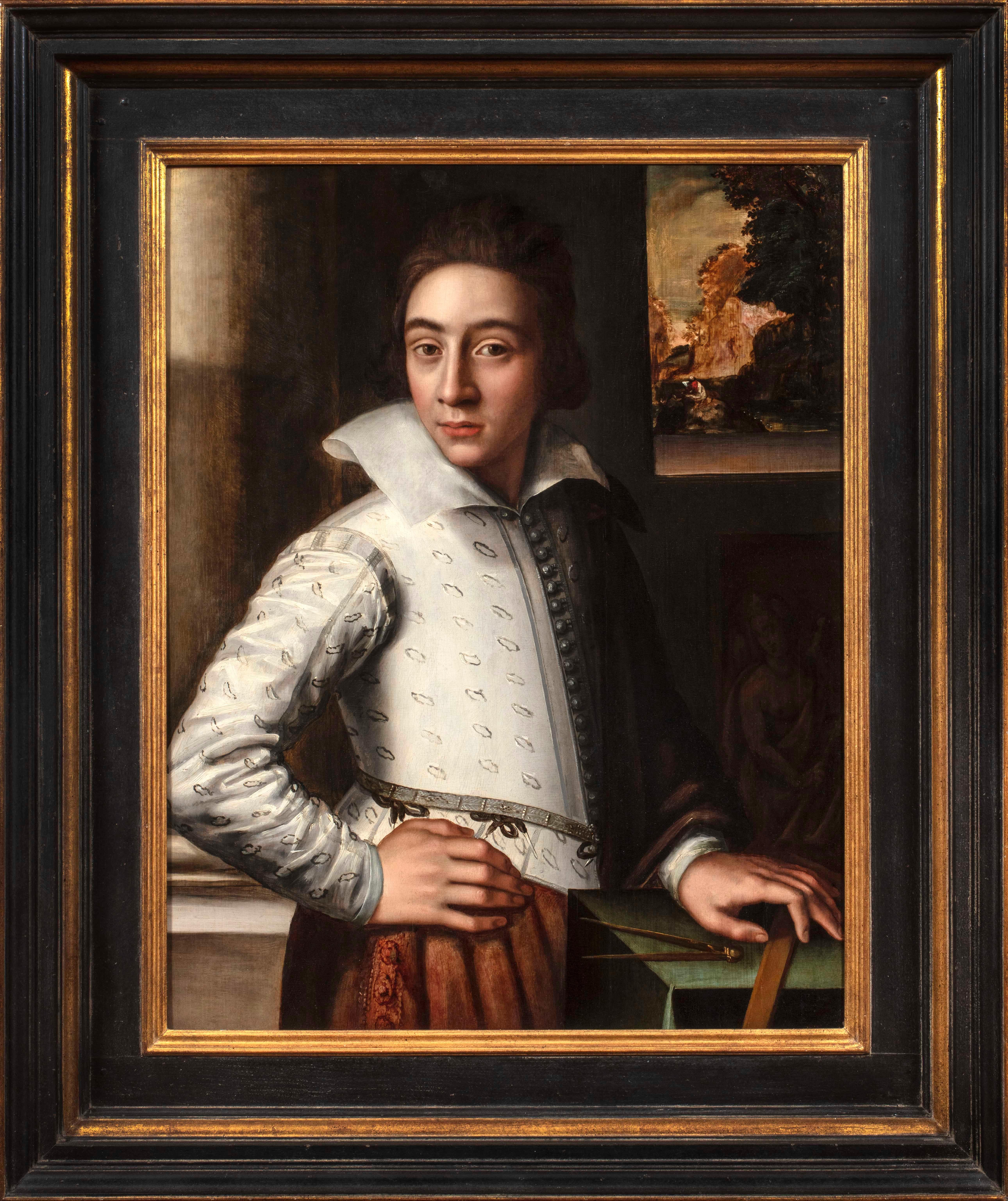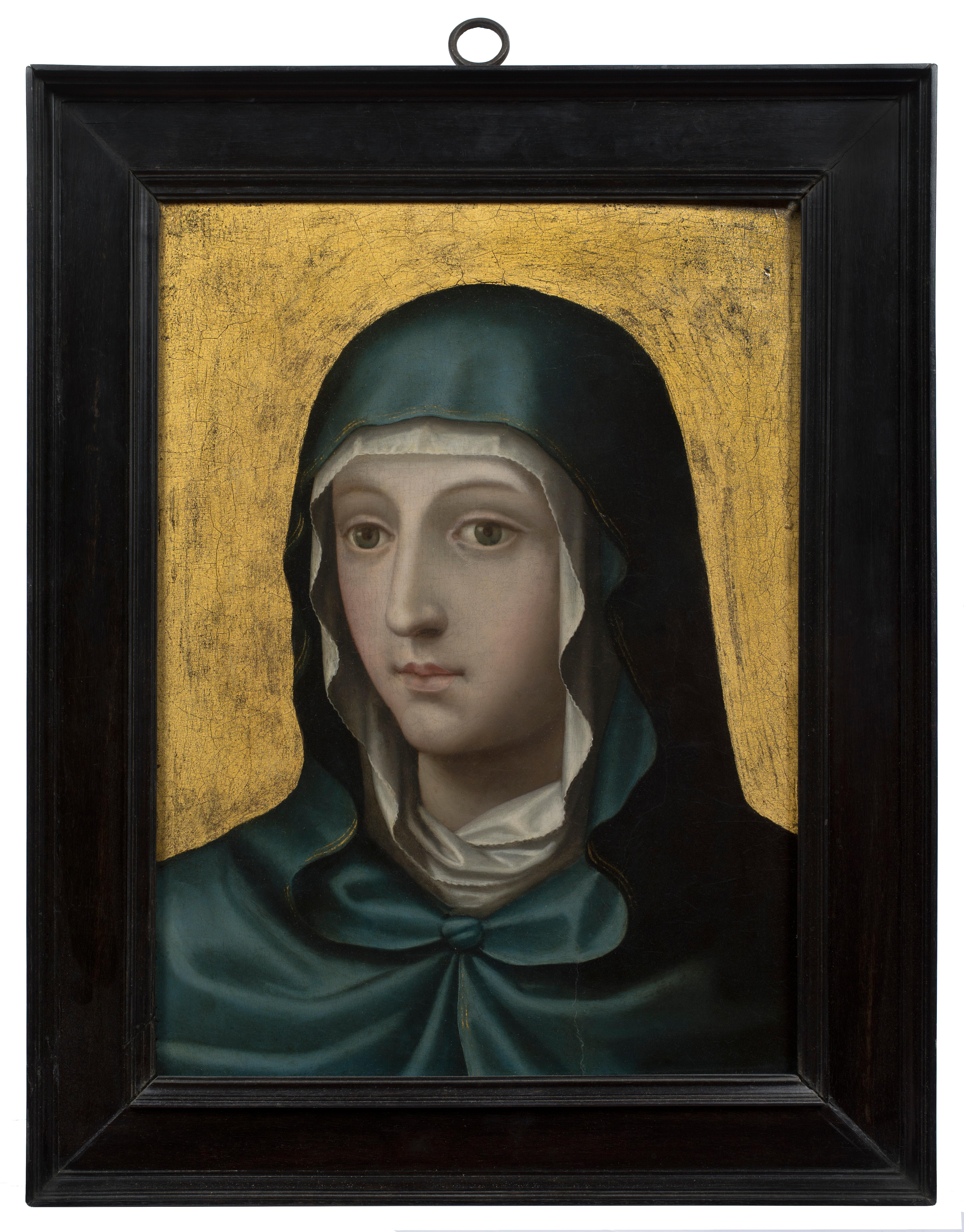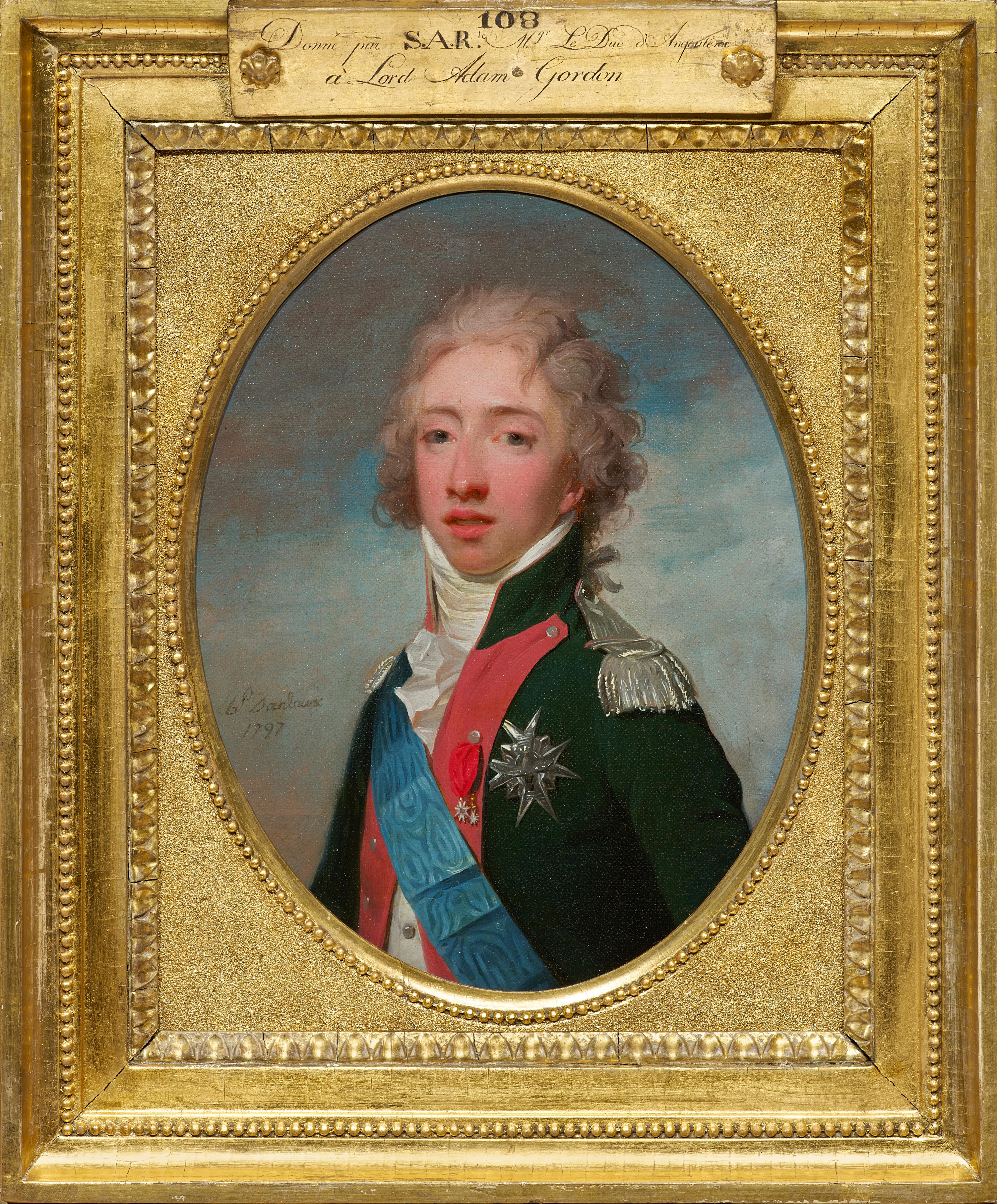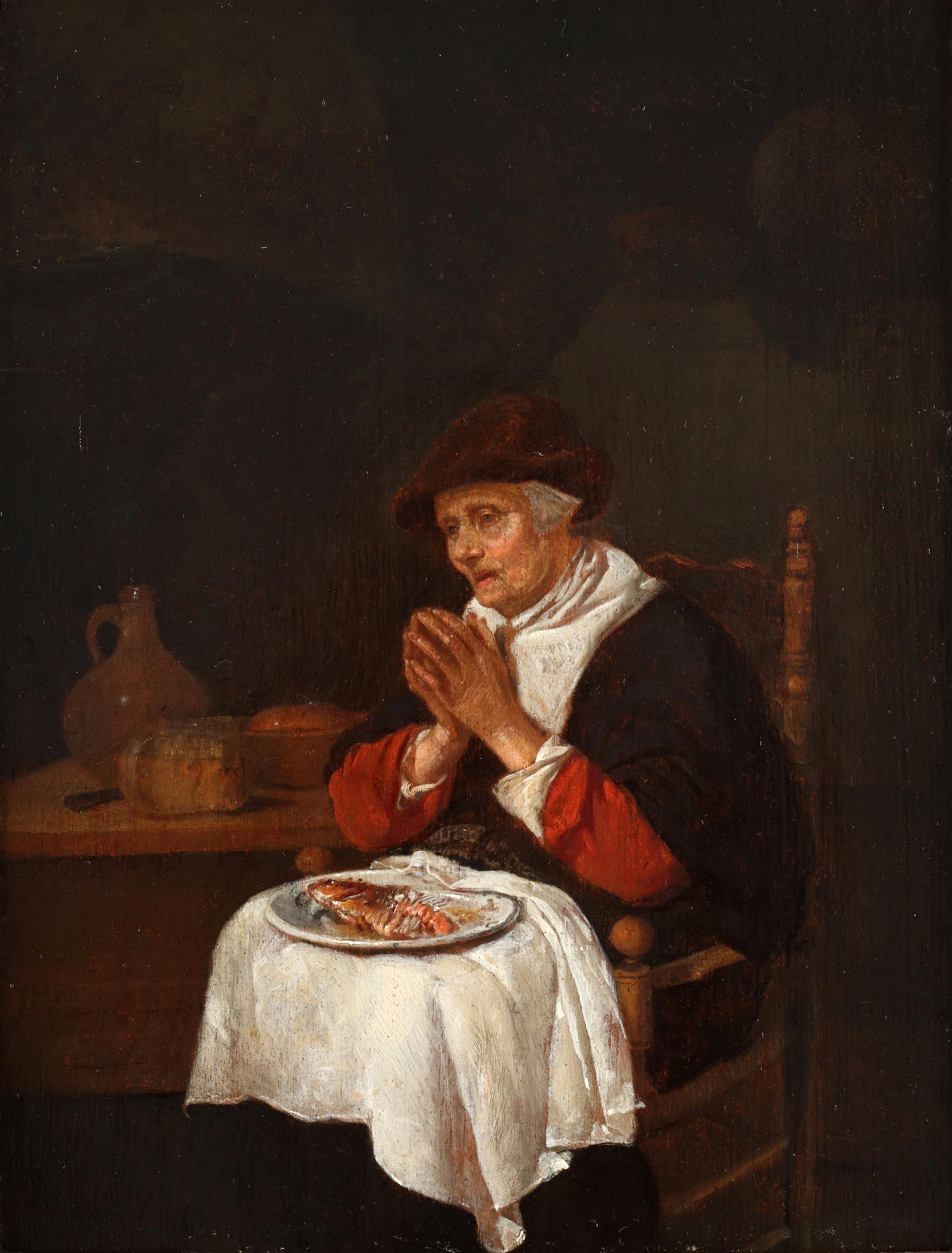Items Similar to Portrait of three children - Bernhard Keil (1624-1687)
Want more images or videos?
Request additional images or videos from the seller
1 of 7
Bernhard KeilPortrait of three children - Bernhard Keil (1624-1687)
About the Item
“A portrait of three children, one of them holding a basket of grapes, while another plays the flute”
Oil on canvas
Housed in a blackened 17th-century frame.
We'd like to thank dr. Fred Meijer and dr. Guido Jansen for their advice.
Dimensions: 70 x 95 cm
Bernhard Keil (Eberhard Keilhau) was a Danish painter, he was the first painter from his country to enjoy more than a local reputation. Keil studied in Copenhagen and then with Rembrandt in Amsterdam, c. 1642-44. In 1651 he moved to Italy, where he lived for the rest of his life, settling in Rome in 1656.
Life-size genre pictures of a few figures were his speciality. His themes are often related to simple allegorical subjects such as the Five Senses, the Seasons, and the Four Elements, and as protagonists he favored dignified old people or children dressed in old clothes and rags. Keil provided Filippo Baldinucci with information about Rembrandt that he used in his book on engraving and etching (1686).
The innocence and joy of childhood comes alive as Keil skillfully captures the essence of three children in a moment of playful camaraderie. The scene unfolds with an intimate focus on their faces, allowing viewers to connect with the charming personalities depicted.
On the left side of the canvas, a girl graces the composition with her presence. Clutching an apple, she exudes a gentle blush, her kind eyes reflecting a sense of sweetness and simplicity. Her brown hair, elegantly arranged in a simple up-do, frames her visage. Adorned in pink and blue attire, she adds a touch of delicate femininity to the trio.
Seated beside her is a boy, perched on a chair and holding a basket of grapes. His face radiates warmth and kindness, mirroring the genuine innocence of childhood. Dressed in a hat, purple and blue clothing, and vibrant red pants, he introduces a playful contrast.
Completing the trio on the right side is another boy, wearing a hat and brown clothing. Engrossed in the melodic pursuit of playing the flute, his lips press against the instrument's head, creating a whimsical visual symphony. His focused expression and the dynamic posture suggest a moment frozen in time, capturing the fleeting joy of childhood pursuits.
Keil's mastery lies not only in the detailed rendering of each child but also in the collective narrative woven through their interactions. The close-up perspective ensures an intimate connection between the viewer and these youthful personalities, inviting contemplation on the universal themes of innocence, playfulness, and the timeless charm of childhood.
- Creator:Bernhard Keil (1624 - 1687, Dutch)
- Dimensions:Height: 28.75 in (73 cm)Width: 38.19 in (97 cm)
- Medium:
- Movement & Style:
- Period:
- Condition:
- Gallery Location:Gent, BE
- Reference Number:1stDibs: LU2239214315052
About the Seller
No Reviews Yet
Vetted Seller
These experienced sellers undergo a comprehensive evaluation by our team of in-house experts.
Established in 1999
1stDibs seller since 2022
- ShippingRetrieving quote...Ships From: Gent, Belgium
- Return PolicyThis item cannot be returned.
More From This SellerView All
- A praying elderly woman by Quiringh Van Brekelenkam (1622-1669)Located in Gent, BEOil on panel Signed and dated lower left. Quiringh van Brekelenkam was a Dutch genre painter, who studied under Gerard Dou. As a result, his paintings from the 1640s and 50s are si...Category
17th Century Old Masters Portrait Paintings
MaterialsOil, Panel
- Two portraits, one of a man and one of a lady - Jan van RavensteynLocated in Gent, BEOil on panel Jan van Ravesteyn was described as an outstanding portrait painter by Karel van Mander as early as 1604. After a possible apprenticeshi...Category
17th Century Dutch School Portrait Paintings
MaterialsOil, Wood Panel
- Portrait of a bearded man - Adriaen Thomasz. Key (c. 1544-1589)Located in Gent, BEOil on panel We are grateful to Koenraad Jonckheere for confirming the attribution after inspection of the original. He dates the work to circa 1570. The present portrait of a bearded man, arresting in its intimacy, capturing the contemplative gaze of the sitter, along with the intense naturalism with which his face is rendered, is an outstanding example of the oeuvre of the Antwerp master Adriaen Thomasz. Key. Attired in an expensive and modish ‘Burgundian black’ doublet...Category
16th Century Flemish School Portrait Paintings
MaterialsOil, Panel
- A portrait of a young boy and Johanna van den Brande - Nicholas MaesLocated in Gent, BEA portrait of a young boy holding a hunting spear and carving words into a tree and A portrait of Johanna van den Brande (1668-1691) - - Nicolaes Maes Oil on canvas The composition of our portrait of a young boy, holds a close resemblance to two other portraits painted by Maes. The first one was to be seen at Woolley and Wallace, in august 2021. It portrayed a young man, older than our boy, in a Japanese rok, also holding a hunting spear and carving words into a tree. The second one is a portrait of Christiaan van...Category
17th Century Dutch School Portrait Paintings
MaterialsCanvas, Oil
- Christine de France, duchesse de Savoi - Franco-Flemish school (17th C.)Located in Gent, BEA portrait of Christine de France, duchesse de Savoi, made with oil paint on canvas. Christine Marie of France (10 February 1606 – 27 December 1663) was Duchess of Savoy from 26 Ju...Category
17th Century Flemish School Portrait Paintings
MaterialsOil
- Portrait of a child holding peaches - Jacob Gerritsz. Cuyp (1594-1652)Located in Gent, BEOil on panel Portrait of a child holding peaches, accompanied by a dog. We are grateful to Fred Meijer for confirming the attribution on the basis of high-resolution photographs. The present portrayal of a silk-robed child, attended by a pedigree puppy and holding a sprig of expensive, exotic fruit, exudes the burgeoning wealth of the mid-17th century Dutch Republic, and is characteristic of the accomplished hand of Jacob Gerritsz. Cuyp. The sex of the present child is difficult to determine with certainty, as young boys also were attired in dresses at this time, but the silk bonnet...Category
17th Century Dutch School Portrait Paintings
MaterialsOil
You May Also Like
- Portrait of a ManLocated in New York, NYProvenance: with Leo Blumenreich and Julius Böhler, Munich, 1924 Dr. Frederic Goldstein Oppenheimer (1881-1963), San Antonio, Texas; by whom given to: Abraham M. Adler, New York, un...Category
16th Century Old Masters Portrait Paintings
MaterialsOil, Panel
- Portrait of an Artist (possibly a Self-Portrait)Located in New York, NYProvenance: Bradley Collection. Private Collection, Upperville, Virginia. Literature: Katlijne van der Stighelen and Hans Vlieghe, Rubens: Portraits of Unidentified and Newly Identified Sitters painted in Antwerp, Corpus Rubenianum Ludwig Burchard, vol. 19, pt. 3, London and Turnhout, 2021, under cat. no. 189, p. 161, and fig. 75. This painting had previously been considered to be by an anonymous Tuscan painter of the sixteenth century in the orbit of Agnolo Bronzino. While the painting does in fact demonstrate a striking formal and compositional similarity to Bronzino’s portraits—compare the nearly identical pose of Bronzino’s Portrait of a Young Man in the Metropolitan Museum of Art (Fig. 1)—its style is completely foreign to Italian works of the period. That it is painted on an oak panel is further indication of its non-Italian origin. This portrait can in fact be confidently attributed to the Antwerp artist Huybrecht Beuckelaer. Huybrecht, the brother of Joachim Beuckelaer, has only recently been identified as the author of a distinct body of work formerly grouped under the name of the “Monogrammist HB.” In recent studies by Kreidl, Wolters, and Bruyn his remarkable career has been delineated: from its beginnings with Joachim in the workshop of Pieter Aertsen; to his evident travels to Italy where, it has been suggested, he came into contact with Bronzino’s paintings; to his return to Antwerp, where he seems to have assisted Anthonis Mor in painting costume in portraits; to his independent work in Antwerp (where he entered the Guild of Saint Luke in 1579); and, later to his career in England where, known as “Master Hubberd,” he was patronized by the Earl of Leicester. Our painting was recently published by Dr. Katlijne van der Stighelen and Dr. Hans Vlieghe in a volume of the Corpus Rubenianum, in which they write that the painting “has a very Italian air about it and fits convincingly within [Beuckelaer’s] oeuvre.” Stighelen and Vlieghe compare the painting with Peter Paul Ruben’s early Portrait of a Man, Possibly an Architect or Geographer in the Metropolitan Museum of Art, in which the sitter holds a compass and wears a similarly styled doublet (Fig. 2). Huybrecht both outlived and travelled further afield than his brother Joachim, who made his career primarily in Antwerp. Whereas Joachim was the main artistic inheritor of their uncle and teacher, Pieter Aertson, working in similar style and format as a specialist in large-scale genre and still-life paintings, Huybrecht clearly specialized as a painter of portraits and was greatly influenced by the foreign artists and works he encountered on his travels. His peripatetic life and his distinctly individual hand undoubtedly contributed to the fact his career and artistic output have only recently been rediscovered and reconstructed. His periods abroad seem to have overlapped with the mature phase of his brother Joachim’s career, who enrolled in the Antwerp Guild of Saint Luke much earlier than his brother, establishing himself as an independent painter in 1560. Joachim’s activity was confined to the following decade and half, and his latest work dates from the last year of his life, 1574. Our portrait was likely produced in the late 1560s, a dating supported by the dendrochronological investigation performed by Dr. Peter Klein, which established that it is painted on an oak panel with an earliest felling date of 1558 and with a fabrication date of ca. 1566. This painting presents a portrait of an artist, almost certainly Huybrecht’s self-portrait. The young sitter is confidently posed in a striking patterned white doublet with a wide collar and an abundance of buttons. He stands with his right arm akimbo, his exaggerated hands both a trademark of Huybrecht and his brother Joachim’s art, as well as a possible reference to the “hand of the artist.” The figure peers out of the painting, interacting intimately and directly with the viewer, as we witness him posed in an interior, the tools and results of his craft visible nearby. He holds a square or ruler in his left hand, while a drawing compass...Category
16th Century Old Masters Paintings
MaterialsOil, Panel
- The Veronica of the Virgin (Verónica de la Virgen)Located in New York, NYThe panel has been attributed both to Joan de Joanes and his son Vicente Macip Comes (Valencia, ca. 1555 – 1623). Provenance: Private Collection, England, by 1886 (according to stencils on the reverse) Private Collection, New Jersey, until 2010 The Veil of Veronica, often called the Sudarium, is one of the most important and well-known relics of Christ. According to legend, Veronica offered Christ her veil as he carried the cross to his crucifixion. He wiped his face with the veil, which left the cloth miraculously imprinted with his image. Depictions of Christ’s face on a veil, or simply images that focused in on Christ’s face, were treasured objects of religious devotion. The popularity of this format also inspired similar images of the face of the Virgin. The iconographic type of the present painting is known as the Veronica of the Virgin, which was especially favored in late medieval and early Renaissance Spain. Distinct from the images of the suffering Christ, the Veronica of the Virgin is based on the legend that Saint Luke painted a portrait of Mary from life. Although scholars have sometimes mistaken them for portraits of Queen Isabella I of Castile (known as Isabel la Católica) or as a depiction of Saint Maria Toribia (known as María de la Cabeza, or, Mary of the Head), paintings like this one were clearly intended as images of the Virgin in the style of Saint Luke’s lost portrait. The Veronica of the Virgin was especially popular in Valencia, and depictions of this subject produced there all stem back to one visual prototype: a Byzantine image in the city’s cathedral (Fig. 1). This early treatment of the Veronica was given to the cathedral in 1437 by Martin the Humane, King of Aragon and Valencia, who promoted religious veneration of the Veronica of the Virgin as part of the celebration of the Immaculate Conception of Mary. This devotion spread throughout Martin’s kingdom and particularly took hold in Valencia, where the Byzantine image resided. The image, which is displayed in a gold reliquary...Category
16th Century Old Masters Paintings
MaterialsOil, Wood Panel
- 18th century portrait of the painter Nathaniel DanceLocated in London, GBCollections: Robert Gallon (1845-1925); Private Collection, UK. Oil on canvas laid down on panel Framed dimensions: 11.5 x 10 inches This highly engaging, previously unpublished portrait by Johan...Category
18th Century Old Masters Portrait Paintings
MaterialsCanvas, Oil, Wood Panel
- Two royal portraits (the Duc d'Angoulême and the Duc de Berry) by H.P. DanlouxLocated in PARIS, FRThese two royal portraits are a major historical testimony to the stay of the Comte d'Artois (the future Charles X) and his family in Edinburgh in 1796-1797. Given by the sitters to Lord Adam Gordon, the Governor of Edinburgh, and kept by family descent to this day, these two portraits provide us with a vivid and spontaneous image of the Duc d’Angoulême and his brother the Duc de Berry. Danloux, who had emigrated to London a few years before, demonstrate his full assimilation of the art of British portrait painters in the brilliant execution of these portraits. 1. Henri-Pierre Danloux, a portraitist in the revolutionary turmoil Born in Paris in 1753, Henri-Pierre Danloux was first a pupil of the painter Nicolas-Bernard Lépicié (1735 - 1784) and then, in 1773, of Joseph-Marie Vien (1716 - 1809), whom he followed to Rome when, at the end of 1775, Vien became Director of the Académie de France. In Rome he became friends with the painter Jacques-Louis David (1748 - 1825). Returning to France around 1782, he settled in Lyon for a few years before returning to Paris in 1785. One of his first portraits was commissioned by the Baroness d'Etigny, the widow of the former Intendant of the Provinces of Gascony, Bearn and Navarre Antoine Mégret d'Etigny (1719 – 1767). He then became close to his two sons, Mégret de Sérilly and Mégret d'Etigny, who in turn became his patrons. In 1787, this close relationship with the d'Etigny family was further strengthened by his marriage to Antoinette de Saint-Redan, a relative of Madame d'Etigny. After his marriage, he left for Rome and did not return to France until 1789. It was during the winter of 1790-1791 that he painted one of his masterpieces, the portrait of Baron de Besenval. Set in a twilight atmosphere, this portrait of an aristocrat who knows that his death is imminent symbolizes the disappearance of an erudite and refined society which would be swept away by the French Revolution. The Jacobin excesses led Danloux to emigrate to England in 1792; many members of his family-in-law who remained in France were guillotined on 10 May 1794. Danloux enjoyed great success as a portrait painter in England before returning to France in 1801. During his stay in England, Danloux was deeply under the influence of English portraitists: his colors became warmer (as shown by the portrait of the Duc d'Angoulême that we are presenting), and his execution broader. 2. Description of the two portraits and biographical details of the sitters The Duc d'Angoulême (1775-1844) was the eldest son of the Comte d'Artois, the younger brother of King Louis XVI (the future King Charles X), and his wife Marie-Thérèse of Savoie. He is shown here, in the freshness of his youth, wearing the uniform of colonel-general of the "Angoulême-Dragons" regiment. He is wearing the blue cordon of the Order of the Holy Spirit, which was awarded to him in 1787, and two decorations: the Cross of Saint-Louis and the Maltese Cross, as he was also Grand Prior of the Order of Malta. Born on 16 August 1775 in Versailles, Louis-Antoine d'Artois followed his parents into emigration on 16 July 1789. In 1792, he joined the émigrés’ army led by the Prince de Condé. After his stay in Edinburgh (which will be further discussed), he went to the court of the future King Louis XVIII, who was in exile at the time, and in 1799 married his first cousin Marie-Thérèse Charlotte of France, the daughter of Louis XVI and the sole survivor of the royal family. The couple had no descendants. He became Dauphin of France in 1824, upon the accession to the throne of his father but played only a minor political role, preferring his military position as Grand Admiral. Enlisted in Spain on the side of Ferdinand VII, he returned home crowned with glory after his victory at Trocadero in 1823. He reigned for a very short time at the abdication of Charles X in 1830, before relinquishing his rights in favor of his nephew Henri d'Artois, the Duc de Bordeaux. He then followed his father into exile and died on 3 June 1844 in Gorizia (now in Italy). His younger brother, the Duc de Berry, is shown in the uniform of the noble cavalry of the émigrés’ Army. He is wearing the blue cordon of the Order of the Holy Spirit, awarded to him in May 1789, and the Cross of Saint-Louis (partly hidden by his blue cordon). Born on 24 January 1778 in Versailles, Charles-Ferdinand d'Artois also followed his parents into emigration and joined the émigrés’ army in 1792. After his stay in Edinburgh, he remained in Great Britain, where he had an affair with Amy Brown...Category
1790s Old Masters Portrait Paintings
MaterialsCanvas, Oil, Wood Panel
- Man in Tavern Smoking a Pipe /// Old Masters Dutch David Teniers Portrait FaceBy David Teniers the YoungerLocated in Saint Augustine, FLArtist: Unknown (Circle of David Teniers the Younger, Flemish, 1610-1690) Title: "Man in Tavern Smoking a Pipe" *No signature found Circa: 1690 Medium: Original Oil Painting on Wooden Board Framing: Framed in an antique gold gesso frame...Category
1690s Old Masters Portrait Paintings
MaterialsGold Leaf





